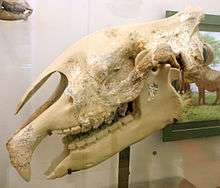Indricotheriinae
| Paraceratheres | |
|---|---|
 | |
| Reconstructed Paraceratherium skull. | |
| Scientific classification | |
| Kingdom: | Animalia |
| Phylum: | Chordata |
| Class: | Mammalia |
| Order: | Perissodactyla |
| Family: | †Hyracodontidae |
| Subfamily: | †Indricotheriinae Osborn, 1923 |
| Genera | |
| Synonyms[1] | |
Paraceratheriidae is a group of long-limbed, hornless rhinoceroses that evolved in the Eocene epoch and continued through to the early Miocene. Early paraceratheres were the size of a dog, but by the late Eocene and early Oligocene, they evolved and quickly grew to huge sizes.[3] They flourished in the rainforests of a coastal region that became Kazakhstan, India, and southwest China, and lived further inland throughout central Asia as well.
The paraceratheres reached the peak of their evolution from the middle Oligocene through to the early Miocene, where they had become enlarged mammals, represented by the specialized genus Paraceratherium. These were among the largest land mammals that ever lived. However, they remained confined to central Asia, which at the time was part of a large, lush lowland region. The collision with the Indian subcontinent and the Himalayan uplift led to global cooling, desertification, and the disappearance of forest habitats, which resulted in the extinction of these giant ungulates.
Although considered a subfamily of Hyracodontidae by some authors, recent authors treat paraceratheres as a distinct family, Paraceratheriidae (Wang et al. 2016 recover hyracodonts as more basal than paraceratheres).[4][5]
References
- ↑ Lucas, S.G.; Sobus, J.C. (1989). "The Systematics of Indricotheres". In Prothero, D. R.; Schoch, R. M. The Evolution of Perissodactyls. New York, New York & Oxford, England: Oxford University Press. pp. 358–378. ISBN 978-0-19-506039-3. OCLC 19268080.
- 1 2 Wood, H.E. (1963). "A Primitive Rhinoceros from the Late Eocene of Mongolia". American Museum Novitates (2146): 1–12.
- ↑ Palmer, D., ed. (1999). The Marshall Illustrated Encyclopedia of Dinosaurs and Prehistoric Animals. London: Marshall Editions. pp. 262–263. ISBN 1-84028-152-9.
- ↑ Z. Qiu and B. Wang. 2007. Paracerathere Fossils of China. Palaeontologia Sinica, New Series C 193(29):1-396
- ↑ H. Wang, B. Bai, J. Meng and Y. Wang. 2016. Earliest known unequivocal rhinocerotoid sheds new light on the origin of Giant Rhinos and phylogeny of early rhinocerotoids. Scientific Reports 6:39607:1-9.